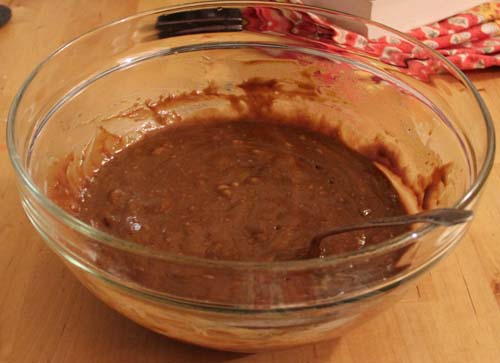Gingerbread
December 25th, 2010
When I was a wee lass, my very favorite cake was my father’s gingerbread. I can remember an early birthday when I insisted on gingerbread. It’s a very dark cake, so all my 4 and 5 year old friends presumed it was chocolate. You should have seen their little faces screwed up in disbelief when they took the first bite. It seems gingerbread is no longer a familiar childhood taste. But once upon a time, its spicy rich molasses flavor was beloved of children everywhere.
Here’s a page from The New England Economical Housekeeper, and Family Receipt Book, by Esther Howland, 1845, featuring a variety of gingerbread receipts. (Thanks to Feeding America: The Historic American Cookbook Project for making this available.) If you want to try any of these, just substitute baking soda for the saleratus.
The only one I’ve tried so far is No. 8. It’s very easy and cheap (and would have been so in the 19th century as well, when molasses was significantly more affordable than white granulated sugar). The hardest part is stirring in enough flour to make it stiff for rolling. I usually end up kneading the last bit once it gets too hard to stir. Then there’s the fun of cutting out shapes — or once or twice when I was in a hurry, I just trimmed it into squares. Baking it for the right amount of time takes a little practice. Too short and the flour tastes raw, too long and they turn hard as rocks. 5 minutes in a 350 degree oven is just about right. Or you can also tell by the smell; once the aroma of ginger and molasses starts to seep out of the oven and a quick peek shows that they have “puffed”, they are done.
Receipts for gingerbread often include the word “family,” in a context suggesting it is meant to be served to children, servants, or anyone that you aren’t trying to impress. Gingerbread is also easy on the stomach (children were thought to have very weak digestion).
One of my favorite gingerbread stories is a chapter in Mary Poppins Opens the Door, by P. L. Travers (written in 1943, but set in turn of the century London).
Mary Poppins takes Jane and Michael and the twins to Mrs. Cory’s shop, where they purchase gingerbread shaped like stars and decorated with gold paper. After the children have eaten their treat, Mary Poppins carefully collects the star-shaped pieces of gold paper and stashes them in her drawer. That night, the children sneak out of their beds to the window, where they see Mary Poppins, Mrs. Cory, and Mrs. Cory’s daughters climbing a ladder into the sky and hanging the paper stars in the sky!
Despite learning to make and enjoy historically accurate gingerbread, my father’s version remains a favorite. I believe he found it in the American Heart Association Cookbook. But it’s surprisingly similar to the receipts in Esther Howland’s cookbook, written more than 125 years earlier. Every time I mix it up, I’m transported back to my family’s kitchen, watching my father stir the batter for endless pans of Christmas gingerbread, and looking forward to licking the bowl.

Notice the beautiful (enormous) glass bowl — a Christmas present from lord and master.
My Father’s Gingerbread
1 Cup Blackstrap Molasses
½ Cup Brown Sugar
½ Cup Oil
½ Tsp Cinnamon
½ Tsp Cloves
½ Tsp Nutmeg
1 Tsp Ginger
1 Cup Boiling Water
2 ½ Cups Unsifted Flour
1 Tsp Baking Soda
½ cup Raisins (optional, I use golden raisins)Mix together sweeteners, spices, and oil. Stir in boiling water. Mix in flour. Dissolve baking soda in 2 Tbsps of hot water. Add to batter. Stir in raisins. Bake in greased square cake pan, 30 minutes at 350 degrees.

Delicious! We’ll eat it tonight for Christmas dessert, with fresh whipped cream.

